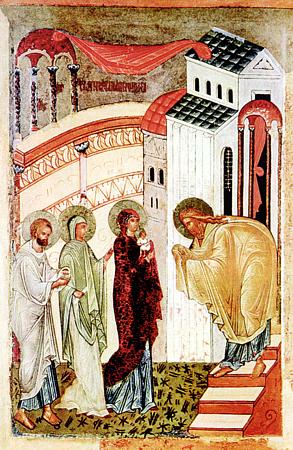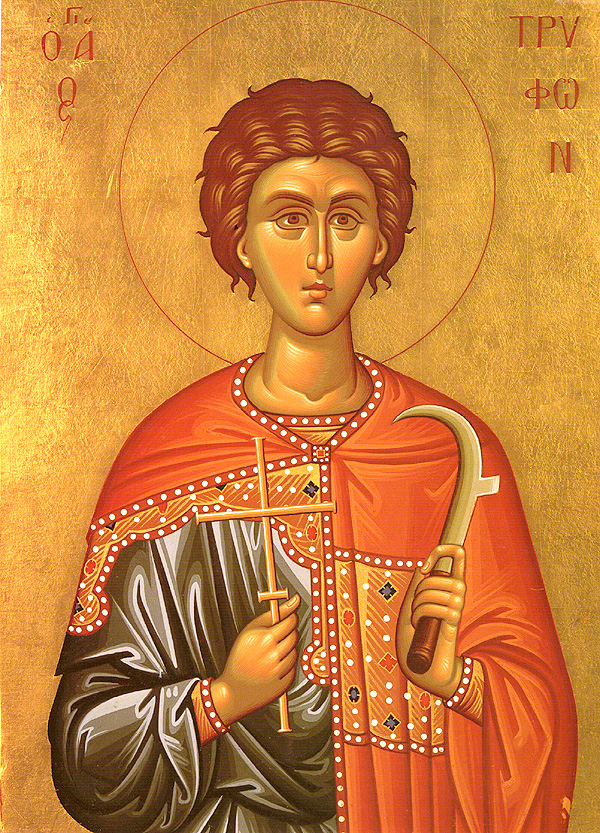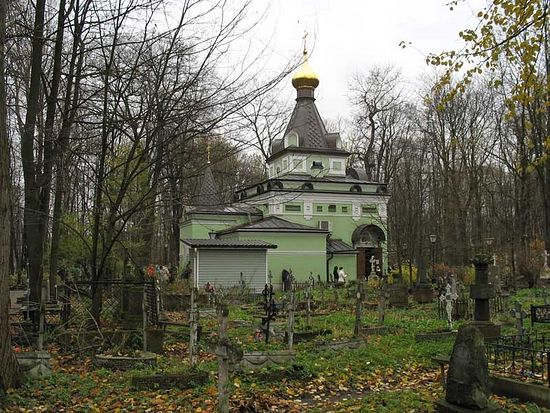Theology
Homily on the Meeting of the Lord
16. February 2017 - 11:22 What a tender scene the Meeting of the Lord shows us! The venerable elder Simeon, holding the infant God in his hands, on either side of him are the righteous Joseph and the Most Holy Mother of God. Not far away is the Prophetess Anna, an eighty-year-old faster and woman of prayer. Their eyes are all directed toward the Savior. Their attention is absorbed by Him and they drink in spiritual sweetness from Him, which feeds their souls. You can judge for yourself how blessed was the state of these souls!
What a tender scene the Meeting of the Lord shows us! The venerable elder Simeon, holding the infant God in his hands, on either side of him are the righteous Joseph and the Most Holy Mother of God. Not far away is the Prophetess Anna, an eighty-year-old faster and woman of prayer. Their eyes are all directed toward the Savior. Their attention is absorbed by Him and they drink in spiritual sweetness from Him, which feeds their souls. You can judge for yourself how blessed was the state of these souls!
However, brethren, we are called not only to think about this blessedness, but also to taste it in reality, for all are called to have and carry the Lord in themselves, and to disappear in Him with all the powers of their spirit. When we have reached that state, then our blessedness will be no lower than that of those who participated in the Meeting of the Lord. They were blessed who saw it; we shall be blessed who have not seen, but believed. Pay attention. I will show you briefly how to achieve this. Here is what you should do.
Martyr Tryphon of Campsada Near Apamea in Syria
13. February 2017 - 11:58 The Martyr Tryphon was born in Phrygia, one of the districts of Asia Minor, in the village of Lampsacus. From his early years the Lord granted him the power to cast out demons and to heal various maladies. He once saved the inhabitants of his native city from starvation. Saint Tryphon, by the power of his prayer, turned back a plague of locusts that were devouring the grain and devastating the fields.
The Martyr Tryphon was born in Phrygia, one of the districts of Asia Minor, in the village of Lampsacus. From his early years the Lord granted him the power to cast out demons and to heal various maladies. He once saved the inhabitants of his native city from starvation. Saint Tryphon, by the power of his prayer, turned back a plague of locusts that were devouring the grain and devastating the fields.
Saint Tryphon gained particular fame by casting out an evil spirit from the daughter of the Roman emperor Gordian (238-244). Helping everyone in distress, he asked only one thing from them: faith in Jesus Christ, by Whose grace he healed them.
The Three Hierarchs: Saint Basil the Great, Saint Gregory the Theologian, and Saint John Chrysostom
11. February 2017 - 14:37 Each of these saints has his own feast day: St. Basil the Great, January 1; St. Gregory the Theologian, January 25; and St. John Chrysostom, January 27. This combined feast day, January 30, was instituted in the eleventh century during the reign of Emperor Alexius Comnenus. Once, a debate arose among the people concerning who among the three was the greatest. Some extolled Basil because of his purity and courage; others extolled Gregory for his unequaled depth and lofty mind in theology; still others extolled Chrysostom because of his eloquence and clarity in expounding the Faith. Thus some were called Basilians, others Gregorians, and the third were called Johannites. This debate was settled by divine providence, to the benefit of the Church and to the even greater glory of the three saints. Bishop John of Euchaita (June 14) had a vision in a dream: At first all three of these saints appeared to him separately in great glory and indescribable beauty, and after that, all three appeared together. They said to him: “As you see, we are one in God and there is nothing contradictory in us; neither is there a first or a second among us.” The saints also advised Bishop John to write a common service for them and to order a common feast day of celebration. Following this wonderful vision, the debate was settled in this manner: January 30 would be designated as the common feast of these three hierarchs. The Greeks consider this feast not only an ecclesiastical feast, but also their greatest national and school holiday.
Each of these saints has his own feast day: St. Basil the Great, January 1; St. Gregory the Theologian, January 25; and St. John Chrysostom, January 27. This combined feast day, January 30, was instituted in the eleventh century during the reign of Emperor Alexius Comnenus. Once, a debate arose among the people concerning who among the three was the greatest. Some extolled Basil because of his purity and courage; others extolled Gregory for his unequaled depth and lofty mind in theology; still others extolled Chrysostom because of his eloquence and clarity in expounding the Faith. Thus some were called Basilians, others Gregorians, and the third were called Johannites. This debate was settled by divine providence, to the benefit of the Church and to the even greater glory of the three saints. Bishop John of Euchaita (June 14) had a vision in a dream: At first all three of these saints appeared to him separately in great glory and indescribable beauty, and after that, all three appeared together. They said to him: “As you see, we are one in God and there is nothing contradictory in us; neither is there a first or a second among us.” The saints also advised Bishop John to write a common service for them and to order a common feast day of celebration. Following this wonderful vision, the debate was settled in this manner: January 30 would be designated as the common feast of these three hierarchs. The Greeks consider this feast not only an ecclesiastical feast, but also their greatest national and school holiday.
Weekly Diocesan Bulletin - Sunday, February 12, 2017
11. February 2017 - 14:29 Sunday of the Prodigal Son; The Three Holy Hierarchs: Saints Basil the Great, Gregory the Theologian, and John Chrysostom
Sunday of the Prodigal Son; The Three Holy Hierarchs: Saints Basil the Great, Gregory the Theologian, and John Chrysostom
RESURRECTIONAL TROPARION - TONE ONE: When the stone had been sealed by the Jews; while the soldiers were guarding Thy most pure Body; Thou didst arise on the third day, O Savior, granting life to the world. The powers of heaven therefore cried to Thee, O Giver of Life: Glory to Thy Resurrection, O Christ! Glory to Thy Kingdom! Glory to Thy dispensation, O Thou who lovest mankind.
We’ve Come to Matushka… Remembering Blessed Xenia
10. February 2017 - 10:45 The Smolensk cemetery in St. Petersburg is like a sleeping child—profound peace and purity wafts through its alleys. What don’t we come to Blessed Xenia for! To cry over our woes, to pray for success—and each person is locked inside himself, his troubles or joys… In his prayer. And this is understandable; it would be terrible to come to St. Xenia just to have a look at the people. But for the first time I have come to the Blessed One not for the sake of prayer but for the sake of those who are praying. I look around and peer at them.
The Smolensk cemetery in St. Petersburg is like a sleeping child—profound peace and purity wafts through its alleys. What don’t we come to Blessed Xenia for! To cry over our woes, to pray for success—and each person is locked inside himself, his troubles or joys… In his prayer. And this is understandable; it would be terrible to come to St. Xenia just to have a look at the people. But for the first time I have come to the Blessed One not for the sake of prayer but for the sake of those who are praying. I look around and peer at them.
The Gratitude of the Publican
6. February 2017 - 16:51 In the Name of the Father, the Son, and the Holy Spirit.
In the Name of the Father, the Son, and the Holy Spirit.
How short, and how well known today’s parable, and yet, how intense its message, how challenging...

